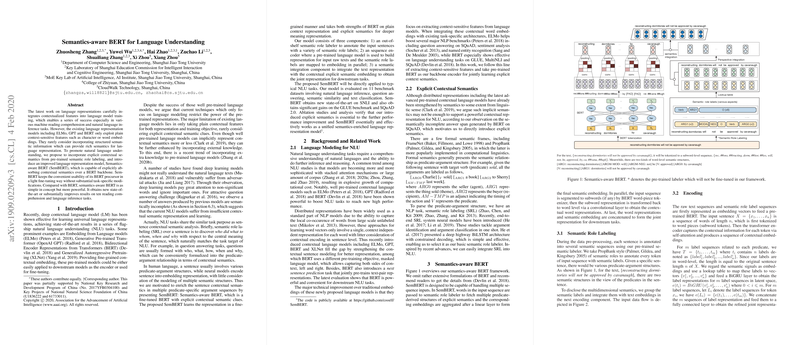Semantics-aware BERT for Language Understanding
The paper "Semantics-aware BERT for Language Understanding" presents a compelling advancement in the construction of language representation models by leveraging explicit contextual semantics, integrated into the Bidirectional Encoder Representations from Transformers (BERT) backbone. The core proposition of the work is the enhancement of BERT with semantic role labeling (SRL), thereby introducing SemBERT as an advanced LLM which meticulously integrates structured semantic information.
Contributions and Methodology
The authors critique existing models such as ELMo, GPT, and BERT for their dependence on plain context-sensitive features and their insufficient exploitation of explicit contextual semantics. Their primary contribution is SemBERT, which enriches BERT’s architecture by embedding explicit semantic information drawn from SRL, aligning it with the inherent contextual representation capabilities of BERT. The process is meticulously engineered to be computationally efficient, maintaining ease of use akin to BERT without the necessity for extensive task-specific modifications. This integration results in enhanced performance across a range of natural language understanding (NLU) tasks.
The model architecture consists of three main components:
- Semantic Role Labeler: An off-the-shelf SRL component labels input sentences, delivering a multi-dimensional semantic representation.
- Sequence Encoder: This component outputs contextual embeddings via a transformer over a tokenized input sequence.
- Semantic Integration: It fuses text-based and semantically enriched embeddings to form an integrated representation ready for downstream tasks.
Experiments demonstrate significant performance improvements with SemBERT compared to baseline BERT on diverse NLU tasks, including machine reading comprehension, natural language inference, and semantic similarity tasks.
Numerical Results and Bold Claims
SemBERT achieves new state-of-the-art results, notably on datasets such as SNLI and SQuAD 2.0, demonstrating its robustness. This efficacy across tasks suggests the crucial role explicit semantics play in enhancing model predictive performance. In particular, the improvement in small dataset scenarios like RTE and MRPC underscores the model's robustness in data-scarce environments.
Implications and Future Directions
The research underlines the viability of semantic augmentation in pre-trained LLMs, yielding significant gains. The success of SemBERT suggests potential avenues for enhancement in other domains where contextual understanding and semantic nuance are critical. Furthermore, the model's robustness to errors in semantic labeling indicates feasibility for application across languages, extending the potential reach of this approach.
Future exploration could target the integration of other forms of external knowledge, extending beyond SRL and addressing limitations like domain transferability and coverage in less-resourced languages. With SemBERT setting a new benchmark, continued exploration of semantics-focused model architectures could lead to further significant advancements in the field of natural language processing.
In sum, "Semantics-aware BERT for Language Understanding" makes a substantive contribution to language representation models by demonstrating the utility of merging explicit contextual semantics with pre-trained language architectures, delivering notable improvements in language understanding tasks.
